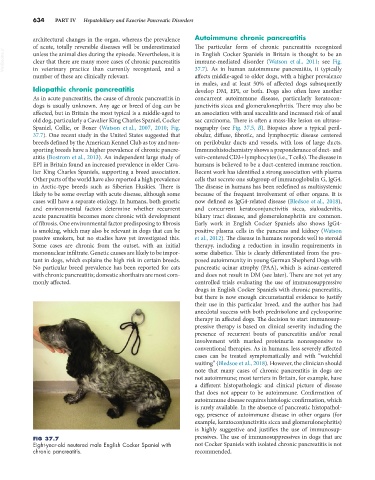Page 662 - Small Animal Internal Medicine, 6th Edition
P. 662
634 PART IV Hepatobiliary and Exocrine Pancreatic Disorders
architectural changes in the organ, whereas the prevalence Autoimmune chronic pancreatitis
of acute, totally reversible diseases will be underestimated The particular form of chronic pancreatitis recognized
VetBooks.ir unless the animal dies during the episode. Nevertheless, it is in English Cocker Spaniels in Britain is thought to be an
immune-mediated disorder (Watson et al., 2011; see Fig.
clear that there are many more cases of chronic pancreatitis
in veterinary practice than currently recognized, and a
affects middle-aged to older dogs, with a higher prevalence
number of these are clinically relevant. 37.7). As in human autoimmune pancreatitis, it typically
in males, and at least 50% of affected dogs subsequently
Idiopathic chronic pancreatitis develop DM, EPI, or both. Dogs also often have another
As in acute pancreatitis, the cause of chronic pancreatitis in concurrent autoimmune disease, particularly keratocon-
dogs is usually unknown. Any age or breed of dog can be junctivitis sicca and glomerulonephritis. There may also be
affected, but in Britain the most typical is a middle-aged to an association with anal sacculitis and increased risk of anal
old dog, particularly a Cavalier King Charles Spaniel, Cocker sac carcinoma. There is often a mass-like lesion on ultraso-
Spaniel, Collie, or Boxer (Watson et al., 2007, 2010; Fig. nography (see Fig. 37.5, B). Biopsies show a typical peril-
37.7). One recent study in the United States suggested that obular, diffuse, fibrotic, and lymphocytic disease centered
breeds defined by the American Kennel Club as toy and non- on perilobular ducts and vessels, with loss of large ducts.
sporting breeds have a higher prevalence of chronic pancre- Immunohistochemistry shows a preponderance of duct- and
atitis (Bostrom et al., 2013). An independent large study of vein-centered CD3+ lymphocytes (i.e., T cells). The disease in
EPI in Britain found an increased prevalence in older Cava- humans is believed to be a duct-centered immune reaction.
lier King Charles Spaniels, supporting a breed association. Recent work has identified a strong association with plasma
Other parts of the world have also reported a high prevalence cells that secrete one subgroup of immunoglobulin G, IgG4.
in Arctic-type breeds such as Siberian Huskies. There is The disease in humans has been redefined as multisystemic
likely to be some overlap with acute disease, although some because of the frequent involvement of other organs. It is
cases will have a separate etiology. In humans, both genetic now defined as IgG4-related disease (Bledsoe et al., 2018),
and environmental factors determine whether recurrent and concurrent keratoconjunctivitis sicca, sialoadenitis,
acute pancreatitis becomes more chronic with development biliary tract disease, and glomerulonephritis are common.
of fibrosis. One environmental factor predisposing to fibrosis Early work in English Cocker Spaniels also shows IgG4-
is smoking, which may also be relevant in dogs that can be positive plasma cells in the pancreas and kidney (Watson
passive smokers, but no studies have yet investigated this. et al., 2012). The disease in humans responds well to steroid
Some cases are chronic from the outset, with an initial therapy, including a reduction in insulin requirements in
mononuclear infiltrate. Genetic causes are likely to be impor- some diabetics. This is clearly differentiated from the pro-
tant in dogs, which explains the high risk in certain breeds. posed autoimmunity in young German Shepherd Dogs with
No particular breed prevalence has been reported for cats pancreatic acinar atrophy (PAA), which is acinar-centered
with chronic pancreatitis; domestic shorthairs are most com- and does not result in DM (see later). There are not yet any
monly affected. controlled trials evaluating the use of immunosuppressive
drugs in English Cocker Spaniels with chronic pancreatitis,
but there is now enough circumstantial evidence to justify
their use in this particular breed, and the author has had
anecdotal success with both prednisolone and cyclosporine
therapy in affected dogs. The decision to start immunosup-
pressive therapy is based on clinical severity including the
presence of recurrent bouts of pancreatitis and/or renal
involvement with marked proteinuria nonresponsive to
conventional therapies. As in humans, less severely affected
cases can be treated symptomatically and with “watchful
waiting” (Bledsoe et al., 2018). However, the clinician should
note that many cases of chronic pancreatitis in dogs are
not autoimmune; most terriers in Britain, for example, have
a different histopathologic and clinical picture of disease
that does not appear to be autoimmune. Confirmation of
autoimmune disease requires histologic confirmation, which
is rarely available. In the absence of pancreatic histopathol-
ogy, presence of autoimmune disease in other organs (for
example, keratoconjunctivitis sicca and glomerulonephritis)
is highly suggestive and justifies the use of immunosup-
FIG 37.7 pressives. The use of immunosuppressives in dogs that are
Eight-year-old neutered male English Cocker Spaniel with not Cocker Spaniels with isolated chronic pancreatitis is not
chronic pancreatitis. recommended.

